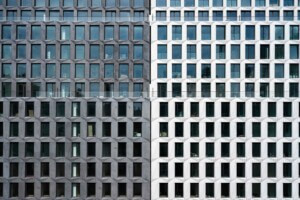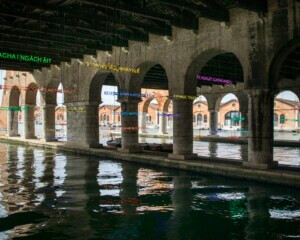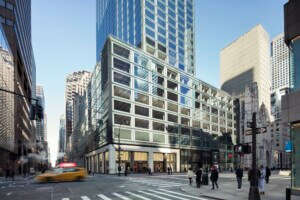Measuring Infinity
Guggenheim Museum
New York
Through September 10
There is something riveting about structures on the verge of collapse. Aware of our breath next to a stack of cards, we worry and delight in their precarity. The art of Gertrud Goldschmidt, an artist widely known as Gego, thrillingly toes this line in Measuring Infinity, a retrospective of her work now on view at the Guggenheim in New York. First trained as an architect and engineer in her native Germany, Gego fled the Nazi regime in 1939 to avoid persecution due to her Jewish heritage, along with so many others. She immigrated to Venezuela, since it was the only visa she could get, settling permanently in Caracas and grounding her then-emergent art practice in her adopted country. The resulting drawings, collages, and sculptures flow up the building’s famous circuitous ramp, exploring the relationships of “line, space, and volume.”
Midcentury Venezuela was a hotbed of artistic innovation. Artists like Alejandro Otero, Jesús Rafael Soto, and Carlos Cruz-Diez were developing the field of geometric expression and kinetic art, ironically with the support of a military dictatorship due to its interest in presenting as culturally relevant. Inspired by the growing field of abstract work emerging from these movements, Gego left freelance architecture jobs for good after marrying her second husband, Lithuanian-born graphic designer Gerd Leufert. For the rest of her life, art would be the center—she made work that challenged modernist constraints by internalizing the formal experimentation surrounding her. Gego refused to make sculpture that adhered to the rules of “three-dimensional forms in solid material,” as she wrote in a notebook, making figures that play tricks on the eye by being simultaneously flat and voluminous, standing and afloat, moving and still.


In the gallery just off the lobby, large wire figures perform different attitudes. The forms of bubbles and towers seemed impossibly delicate and structurally impossible. I tried to photograph them, but photos fail to capture their energy. I zoom into the hooks that keep the light construction geometries upright, at least snagging some basic assembly data. A personal favorite has layers of diagonal rods, creating a contrapposto effect that oscillates with each stack, making it feel like a body in motion. The layers are held in place with small interlocking, hooked ends, nearly invisible from across the gallery. This is hummingbird engineering: fragile and light, complex and robust. But it is also optically elusive: When attempting to take a picture, the three-dimensional form immediately becomes a line drawing on my screen. This experience is emblematic of the relationship between Gego’s drawings and models, which use such a similar language of lines: The models are sometimes referred to as “drawings in space.” In the middle of the gallery, a fuzzy column of wire holds a single darker line zooming upward: as Paul Klee might put it, Gego took a line for a walk.


Earlier works, however, begin to lead us up the ramp. Made immediately after her immigration to Venezuela in 1939, they are mostly colorful landscape paintings. These early experiments traverse Gego’s nearly two-decade transition from architecture to art. But these important early canvases quickly morph in the next section into the kinetic line drawings inspired by her Venezuelan geometric expressionist contemporaries. Fields of lines break and join with each other in waves in prints and drawings, a continuation of scenes reminiscent of the sculpture gallery I just left. Two-dimensional works then finally find solid forms as iron plates and ribbons made of lines ripple moiré-like as you pass: her first sculptures. Ridged plates of lines skewer each other in a precarious stack, this time as a trio of smaller sculptures whose nearly mille-feuille layers make unexpected fuzz.
Her larger installations and sculptures, shown in prominent public spaces throughout Caracas, are re-presented in the Guggenheim through photographic means. In a wall of photos, large works are shown both during and after Venezuela’s mid century dictatorship. The artist resisted government commissions during this time to avoid supporting its theater of progressiveness. While not in the Guggenheim itself, photographs of architecturally-scaled sculptures reach multi-story heights: Escultura para el Banco Industrial de Venezuela in the courtyard of Banco Industrial de Venezuela in 1962, and Cuerdas’ (Estructuras aéreas ambientales) twist across rooflines over the Parque Central in 1972. Small studies in lithography and collage reveal her explorations of form, leading to another series of large photographs of the large-scale environmental Reticularea installations. Children playing under a triangular wire netting of a Reticularea is an example of where the work performs as what she described as a “penetrable” structure or a habitable sculpture at an architectural scale.

These are variations on Reticulareas, loosely translated as “area of nets.” In 1979, poet Alfredo Silva Estrada wrote an homage to her works of the same name, Variations sober Reticulareas. The poem uses Gego’s forms as a way to measure infinity, paradoxically, though their finite bounds. The nets stretch out from platonic solids to inhabitable environmental installations that conjure Silva’s infinite through triangular and square units pixels.
The exhibition text describes Gego as “one of the most significant artists to emerge from Latin America during the second half of the twentieth century.” There is much to be gleaned from her work’s magical, slippery engineering, whose illusions still delude viewers decades later. As Cotter said in a New York Times review of the show, “the smooth, cool, official Modernism of decades past—which Gego never subscribed to—is long gone.” But our built environment is still informed by modernist lessons. The methods of Gego’s world of precarity, infinity, and ambiguity is something we can still learn from—and be dazzled by.
Angie Door is a writer and designer who lives in Brooklyn.











